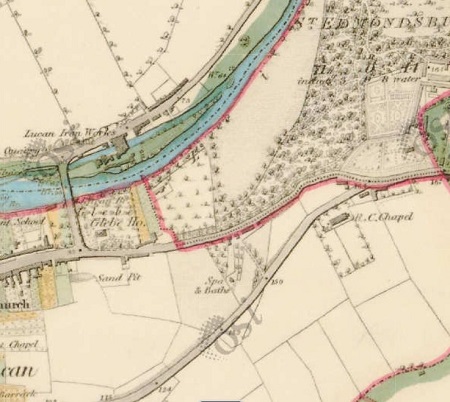|
<< Back to the main Local History page
On Sunday 28 March 2020, when celebrating Mass in an empty church but with lots of parishioners participating online from their homes, Fr. Philip mentioned that he had chosen to use Fr. Fay’s chalice which dates from 1761 (see earlier article in the Lucan Newsletter Archive). Many of us welcomed the idea of joining our prayers to those of earlier generations who have prayed in Lucan (and elsewhere) for hundreds of years before us. I thought it might prompt some queries about the history of the building itself and I did some research online and, in particular, in the newspapers collection on FindMyPast (a subscription website for genealogists).
From the Dublin Morning Register of 14 April 1838, I learned that 'the first stone of the new Roman Catholic church of Lucan' was laid at noon, on Monday 16 April 1838, by Colonel Thomas White of Woodlands (now Luttrellstown). The article mentioned that Colonel White had already contributed valuable building materials, that this was ‘one of many instances of his liberality and kindness' and that he and 'his excellent lady' were generous in alleviating 'the wants of the distressed'.
The rationale for building the 'new' church was set out clearly in an article in The Pilot newspaper of 27 September 1839. The chapel they had at that stage, 'built about a century ago' and 'situated in the centre of the village', had become a complete ruin and it was no longer safe to venture under its tottering roof! Broad day light shone through and 'the crazy walls' were no longer able to support 'its mouldering rafters'. The author goes on to say that, seventeen months earlier, thanks to 'voluntary contributions of a faithful people and a generous public, for the adoration of one true and living God', at a cost of £1,300, the curate, Fr. Michael B. Kelly, started the building and 'has now the pleasing gratification to behold, in a nearly finished state, the reward of his pious and indefatigable exertions. The adjoining scenery is beautified by this chaste and classically designed edifice. Its modest head may be seen at a great distance, raised above the surrounding country ... '
Sunday 13 October 1839 was appointed by the Archbishop of Dublin, His Grace the Most Rev Dr. Murray, for the dedication of the church and the Rev Thomas Maguire, (the parish priest of Ballinamore, a very interesting person) who was known as the 'Champion of the Faith' because of his religious zeal and powerful eloquence, was to officiate. The consecration ceremony was to begin at eleven o’clock followed by solemn high Mass and benediction. The October deadline seems to have been missed but the church was consecrated on Sunday 5 January 1840. The Dublin Morning Register of the following day carried a very detailed article on it and even went so far as to say that the church was 'one of the most admired within ten miles' of the city. It describes the ceremonies outside and inside the church, all the celebrants, the music, the choir members and the organist (from Marlborough Street, another interesting person whose wife and sons were singers). Large extracts of Fr. Maguire's sermon (which took some time to deliver and was intended for a pamphlet) were published later in the week - such was the interest in what he had to say.
Some ten days later, on 17 January 1840, the same newspaper agreed 'that the Catholic inhabitants of Lucan owe their beautiful church principally to the exertions of the Rev. Michael B. Kelly, Catholic curate. His services in its regard cannot be too highly praised or appreciated.’ Today we too very much appreciate all that the current parish team are doing to support us through this very unusual and difficult period. To have access to daily Mass online from our local church is comforting and the emphasis on our Christian Hope and the love of God is very calming.
To conclude, I could not locate a map showing Fr. Fay's church of 1761 but this extract, from the Ordnance Survey website, may have been drawn shortly after the consecration of Fr. Kelly's church.

OSI 6 Inch Colour (1829-41), downloaded on 1 April 2020 from http://geohive.maps/
Mary Jackson, 1 April 2020
|

